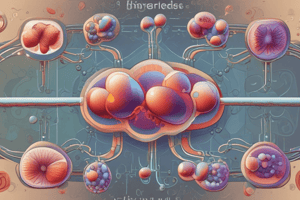Podcast
Questions and Answers
Which one of the following is a common feature of lipids?
Which one of the following is a common feature of lipids?
- Insoluble in water and soluble in nonpolar solvents (correct)
- Soluble in water and diethyl ether
- Insoluble in both water and nonpolar solvents
- Soluble in water and high polarity solvents
What is the main classification criterion for lipids based on function?
What is the main classification criterion for lipids based on function?
- Enzymatic activity
- Structural composition
- Storage, membrane components, and messenger roles (correct)
- Degree of unsaturation
Which of the following is NOT a classification of lipids based on structure?
Which of the following is NOT a classification of lipids based on structure?
- Simple lipids
- Steroids
- Complex lipids
- Amino lipids (correct)
What is the classification of lipids that includes fats, oils, and waxes?
What is the classification of lipids that includes fats, oils, and waxes?
Which type of lipid is involved in roles such as storage and acting as messenger molecules?
Which type of lipid is involved in roles such as storage and acting as messenger molecules?
What type of fatty acids are present in most triglycerides?
What type of fatty acids are present in most triglycerides?
Which of the following is a common physical state for triglycerides at room temperature?
Which of the following is a common physical state for triglycerides at room temperature?
What type of bond is responsible for the fluidity difference between unsaturated and saturated triglycerides?
What type of bond is responsible for the fluidity difference between unsaturated and saturated triglycerides?
Flashcards are hidden until you start studying
Study Notes
Lipids
- Lipids are a family of substances that are insoluble in water but soluble in nonpolar solvents and solvents of low polarity, such as diethyl ether.
- Classification of lipids by function: storage, membrane components, and messenger.
Classification of Lipids
- By function: storage, membrane components, and messenger.
- By structure: simple lipids (fats, oils, and waxes), complex lipids, steroids, prostaglandins, thromboxanes, and leukotrienes.
Triglycerides
- Triglycerides are triesters of glycerol and long-chain carboxylic acids called fatty acids.
- Two types of triacylglycerols: simple triacylglycerols (rare) and mixed triacylglycerols (most common).
- Example of a simple triacylglycerol and a mixed triacylglycerol.
Properties of Triglycerides
- Physical state: triglycerides can be solid (fats) or liquid (oils) at room temperature.
- Saponification: base-promoted hydrolysis of fats and oils producing glycerol and a mixture of fatty acid salts called soaps.
Complex Lipids
- Schematic diagram of simple and complex lipids.
- Complex lipids include phospholipids, glycolipids, and lipoproteins.
Role of Lipids in the Structure of Membrane
- Lipids are components of biological membranes.
- Fatty acids, glycerides, and phospholipids are important for membrane structure.
Classification of Lipids based on Polarity
- Nonpolar lipids: fats, oils.
- Polar lipids: phosphoacylglycerols, sphingolipids.
- Non-fatty acid lipids: terpenes, fat-soluble vitamins.
Types of Fatty Acids
- Saturated fatty acids: have a carbon chain with all single C-C bonds.
- Unsaturated fatty acids: have one or more C-C double bonds.
- Polyunsaturated fatty acids (PUFAs): have multiple C-C double bonds.
- Omega (ω)-3 and omega (ω)-6 fatty acids.
Studying That Suits You
Use AI to generate personalized quizzes and flashcards to suit your learning preferences.




